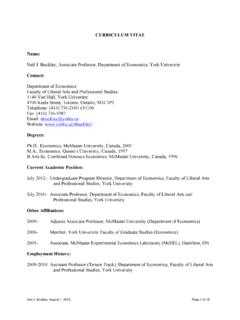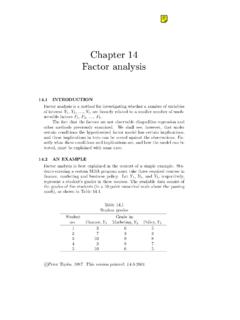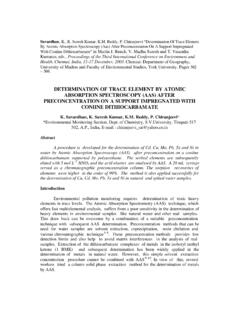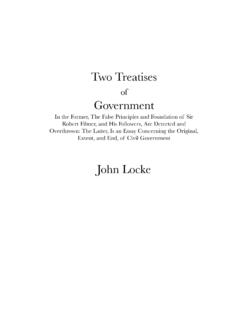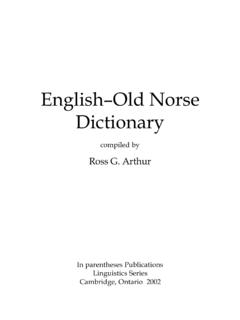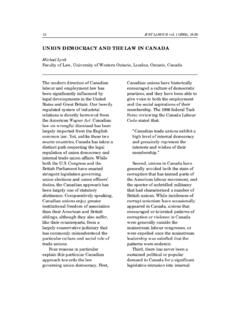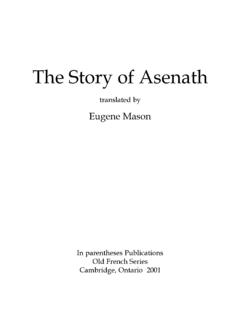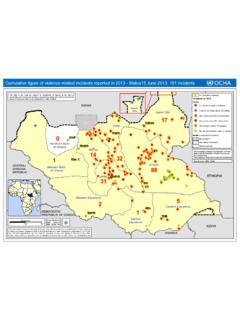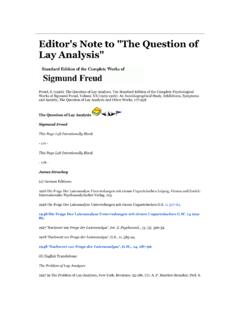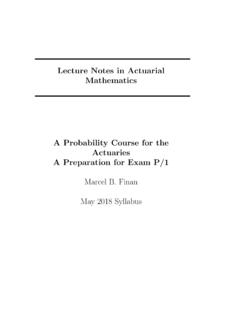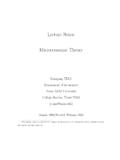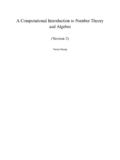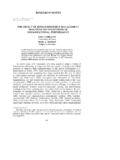Transcription of Chapter 3 Decision theory
1 Chapter 3 Decision INTRODUCTIOND ecision theory deals with methods for determining the optimal course ofaction when a number of alternatives are available and their consequencescannot be forecast with is difficult to imagine a situation which doesnotinvolve such decisionproblems, but we shall restrict ourselves primarily to problems occurring inbusiness, with consequences that can be described in dollars of profitorrevenue, cost or loss. For these problems, it may be reasonable to consideras the best alternative that which results in the highest profit or revenue,or lowest cost or loss, on the average, in the long run.
2 This criterion ofoptimality is not without shortcomings, but it should serve as a useful guideto action in repetitive situations where the consequences are not critical.(Another criterion of optimality, the maximization of expected utility, providesamorepersonalandsubjectiveguidet oactionforaconsistentdecision-maker.)The simplest Decision problems can be resolved by listing the possiblemonetary consequences and the associated probabilities for each alternative,calculating the expected monetary values of all alternatives, and selectingthe alternative with the highest expected monetary value.
3 The determina-tion of the optimal alternative becomes a little more complicated when thealternatives involve sequences of another class of problems, it is possible to acquire often at a certaincost additional information about an uncertain variable. This additionalinformation is rarely entirely accurate. Its value hence, also the maximumamount one would be willing to pay to acquire it should depend on the dif-ference between the best one expects to do with the help of this informationand the best one expects to do without are, then, the types of problems which we shall now begin toexamine in more Peter Tryfos, 3: Decision Decision PROBLEMSVe r y s i m p l y, t h edecision problemis how to select the best of the availablealternatives.
4 The elements of the problem are the possiblealternatives (ac-tions, acts), the possibleevents (states, outcomes of a random process),theprobabilitiesof these events, theconsequencesassociated with each possiblealternative-event combination, and thecriterion ( Decision rule)accordingto which the best alternative is grocery receives its weekly supply of eggs every Thursdaymorning. This shipment must last until the following Thursday when a newshipment is received. Any eggs left unsold by Thursday are destroyed. Eggssell for $10 per hundred and cost $8 per hundred.
5 The weekly demand foreggs at this grocery varies from week to week. From past experience, thefollowing probability distribution is assigned to weekly demand:Demand(hundreds of eggs):1011121314 pattern of demand remains stable throughout the year the demandfor eggs is not seasonal, and the trend isflat. The problem is: How manyeggs should be ordered for delivery every Thursday?The possible alternatives, the possible events, the probabilities of theseevents, and the associated consequences are shown in apayofftable, ble 3 .1 Payofftable(Entries show profit in hundreds of dollars)EventsAlternatives(hundreds of eggs(hundreds of eggs ordered)demanded) 4 profit:2021 20158To illustrate the construction of this table, suppose that12 (hundred)eggs are ordered.
6 The purchase cost is12 8 or 96 (hundreds of dollars). If10 (hundred) eggs are demanded,10 are sold, and the revenue is10 Decision problems3100 ($00); the profit associated with this alternative-event pair is100 96or 4 ($00). Similarly, if demand is12, the profitis(12 10) (12 8)or $24. But if demand is greater than12, only12canbesold,andtheprofit remains $24. We assume that no additional penalty such as loss ofgoodwill is incurred if demand is not now thefirst alternative. If10 are ordered, the profitwillbe$20 no matter what demand happens to be.
7 In contrast, the last alternativeoffers a chance of realizing a profit of $28 but also a chance of a $12loss,as well as chances of in-between profit values. In fact, the profitofeachalternative may be represented by a random variable, which is a functionof the random variable representing demand. For example, if we letYbethe random variable representing the profit of the third alternative, theprobability distribution ofYis:yp(y) , if12 eggs are ordered every Thursday morning, in the long run, aprofit of $4 will be realized in1week out of10, a profitof$14in2,andaprofit of $24 in 7 out of10weeks.
8 Theexpected profit,thatis,thelong-runaverage profit, is simply the mean ofY:(4)( )+(14)( ) + (24)( ) = expected profit of all alternatives is shown in the last row of the payofftable. In this case, it would be quite reasonable to use expected profitasthecriterion for selecting the best alternative. The alternative with the highestaverage profit in the long run is also the one with the highest long-run totalprofit. Thesecondalternative,withanexpectedprofi tof$21,isthebestalternative under this definition of a Decision problem applies, of course, in many situ-ations.
9 In a sense, what one cooks for dinner, whom one marries, whichclothes one buys,..all these are Decision problems. Not all Decision prob-lems will concern us here. For the most part, we shall restrict ourselvesto business problems in which the consequences are measured in dollars ofprofit, revenue, or cost, and in which a reasonable criterion of optimality isto select the alternative with the highestexpected monetary value,thatis,the highest expected profit or revenue, or the lowest expected cost. Theseproblems will tend to be of the repetitive kind, so that the probabilities may4 Chapter 3: Decision theorybe interpreted as the long-run relative frequencies, and theexpected payoffas the average payoffin the long similar criterion of optimality, however, can be applied to a widerclass of Decision problems.
10 As will be explained in the next section, if thedecision-maker is able to act in accordance with certain reasonable rules ofconduct in uncertain situations, then the best act inanydecision problemis the act with the highestexpected utility. The expected utility of an act iscalculated like the expected profit or cost, after replacing each consequenceby its utility roughly, by the personal value of that consequence for SHORTCOMINGS OF EXPECTED MONETARY VALUE,UTILITYIn this section, we examine non-recurring Decision problems in which theconsequences cannot be measured in monetary terms.
